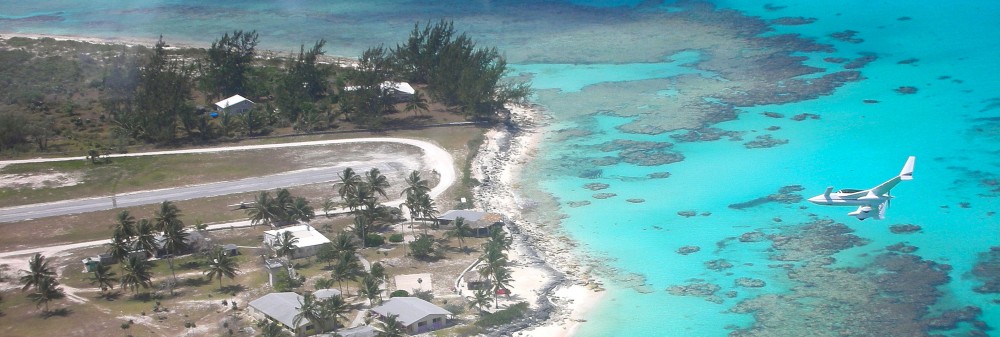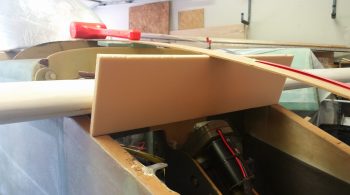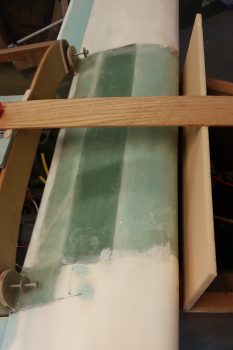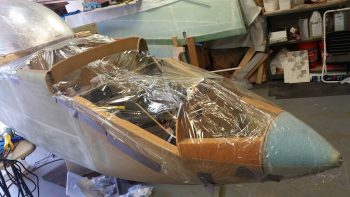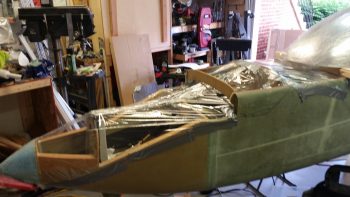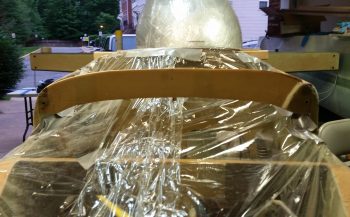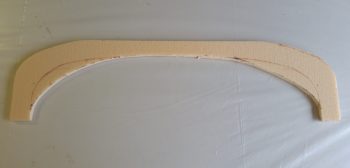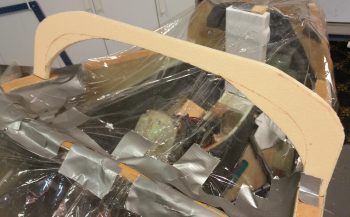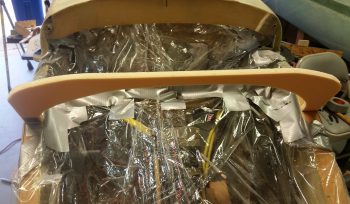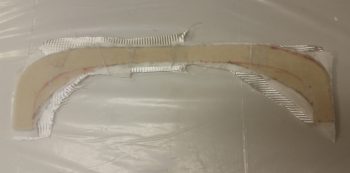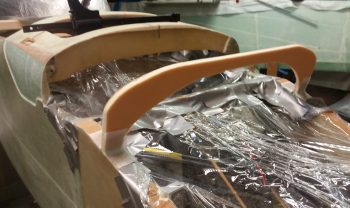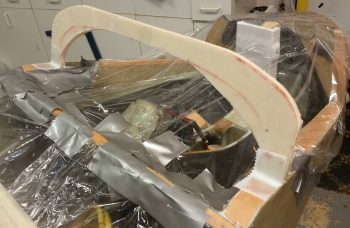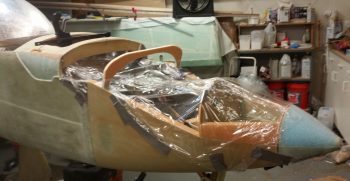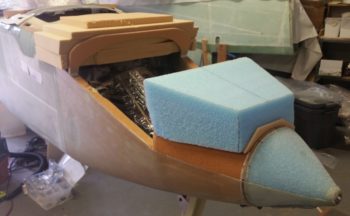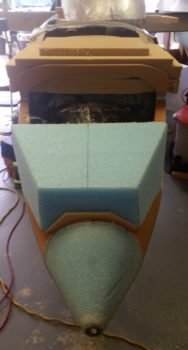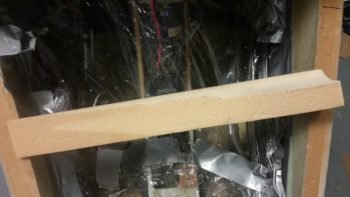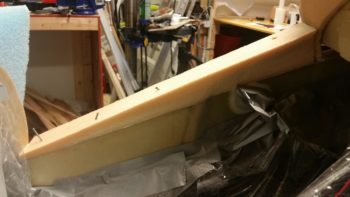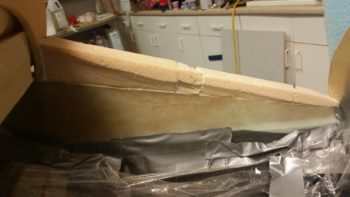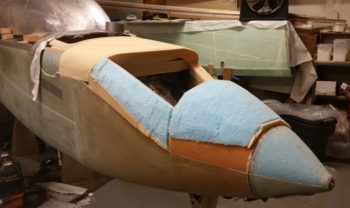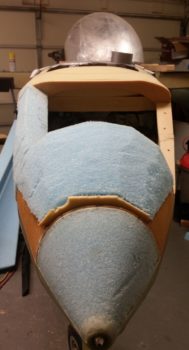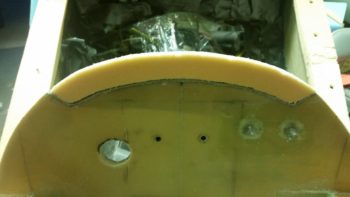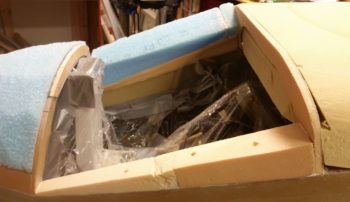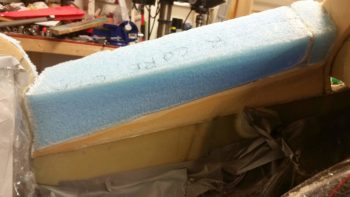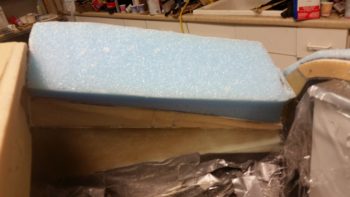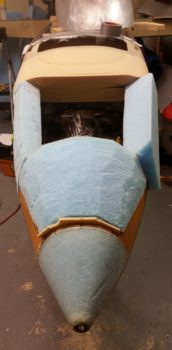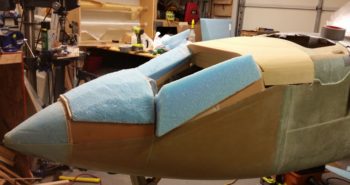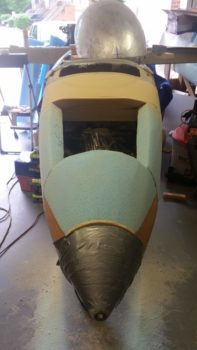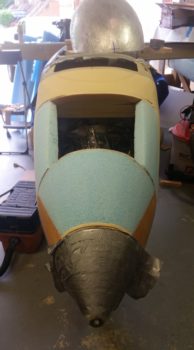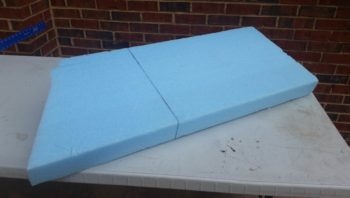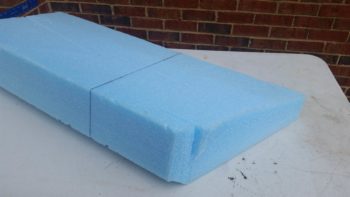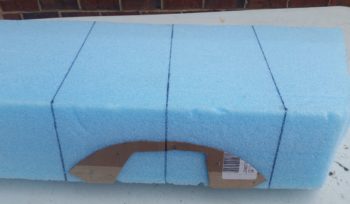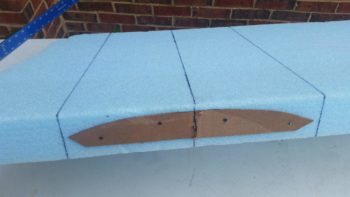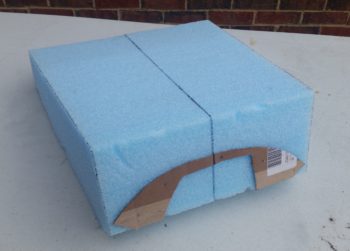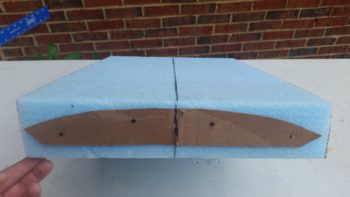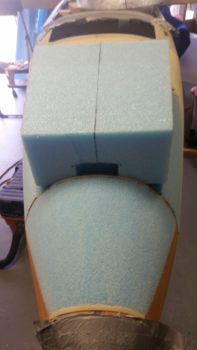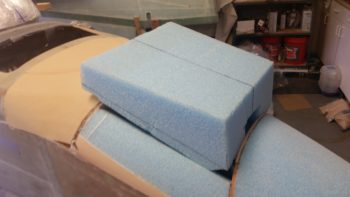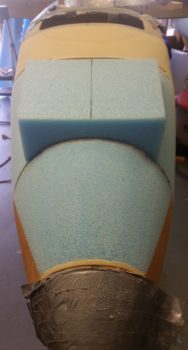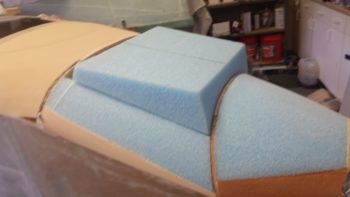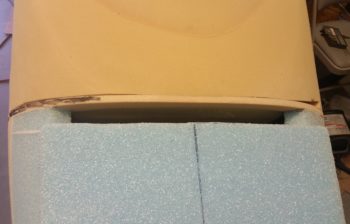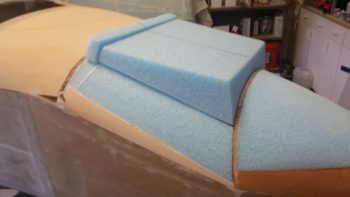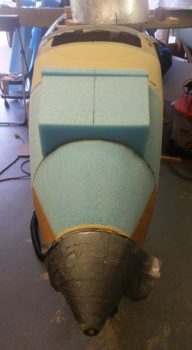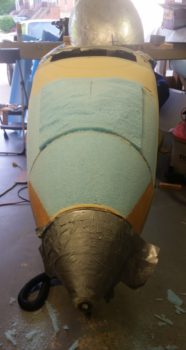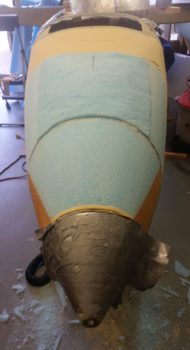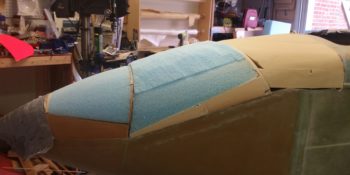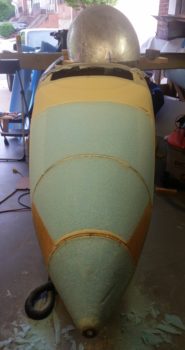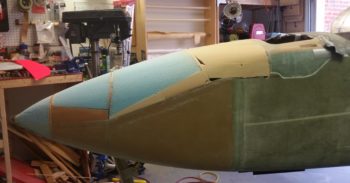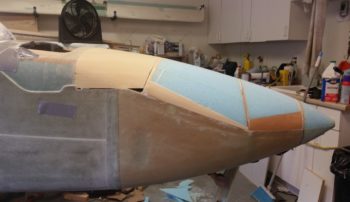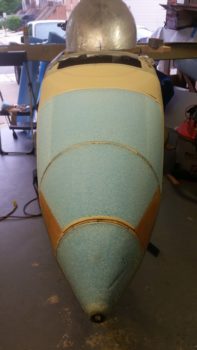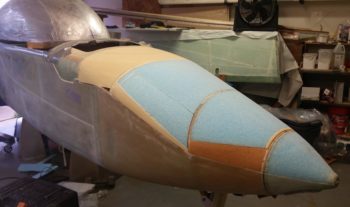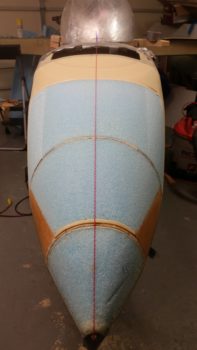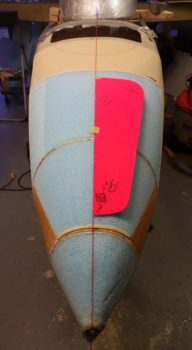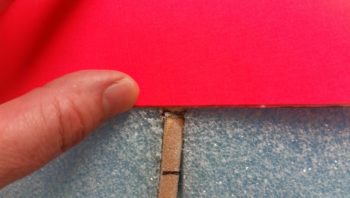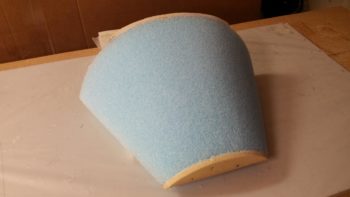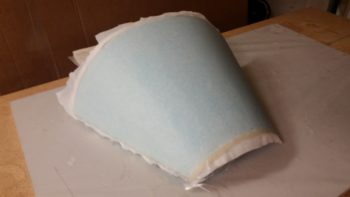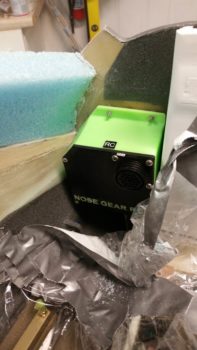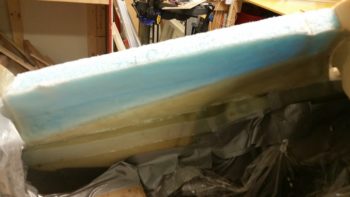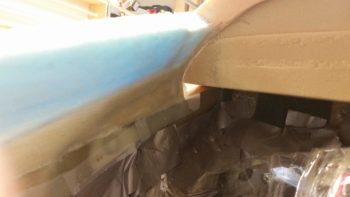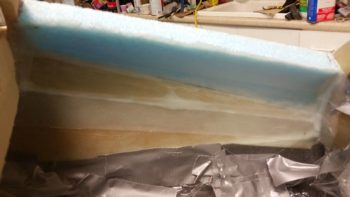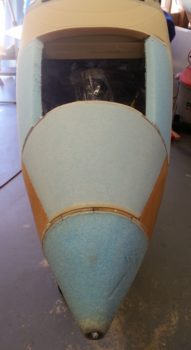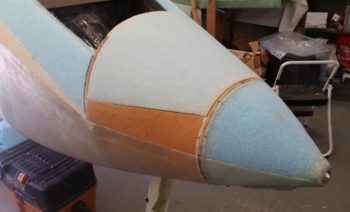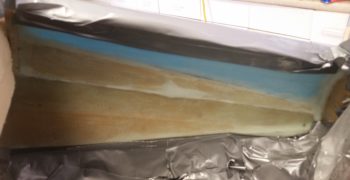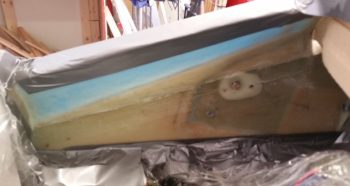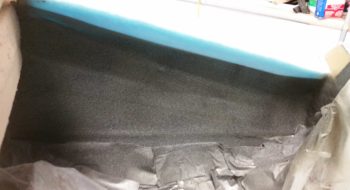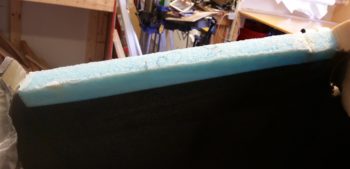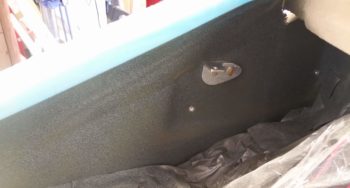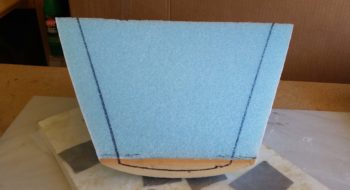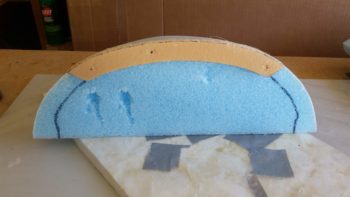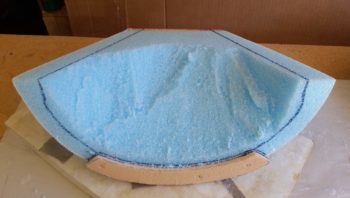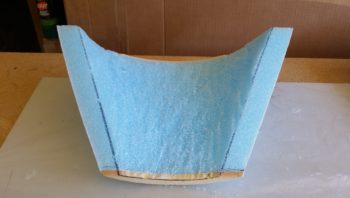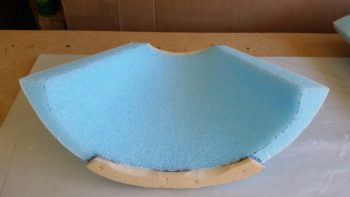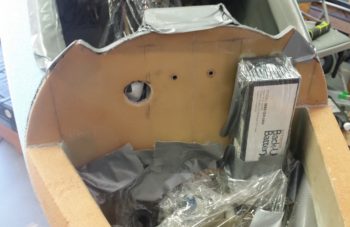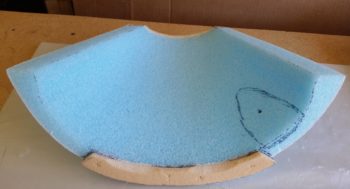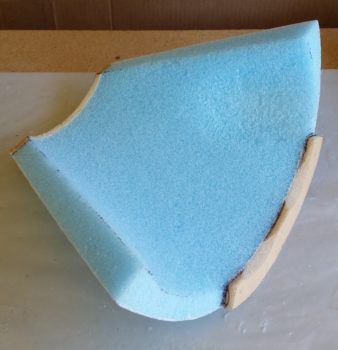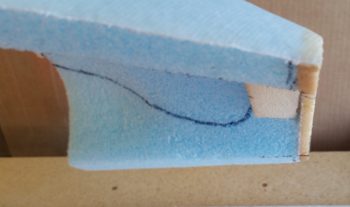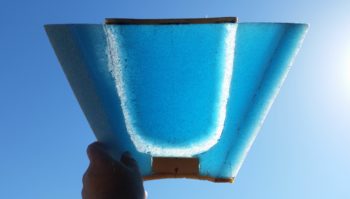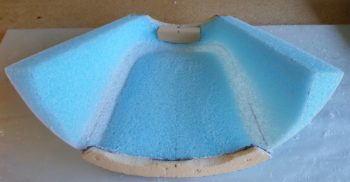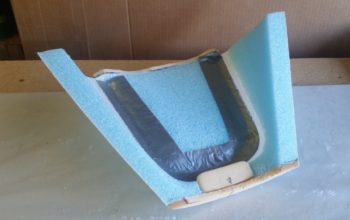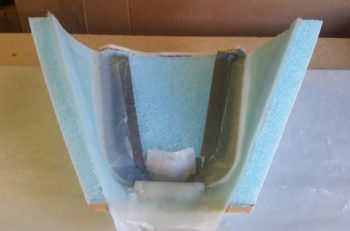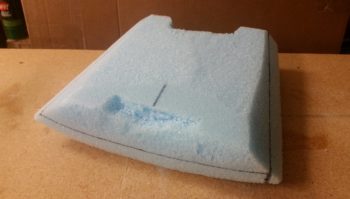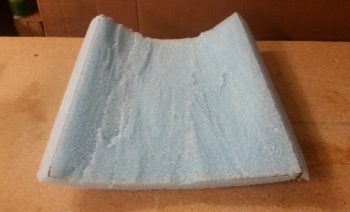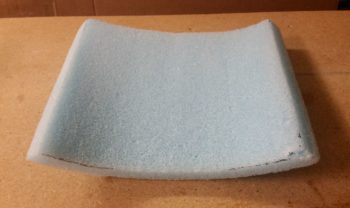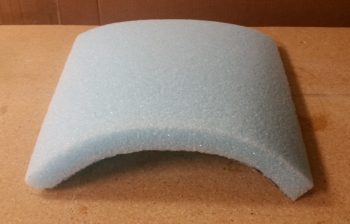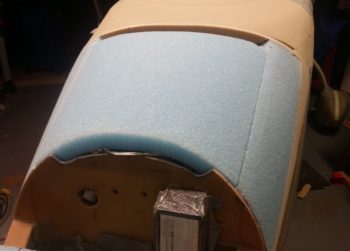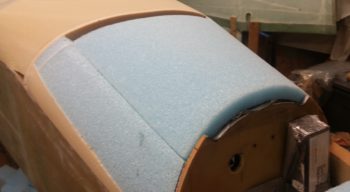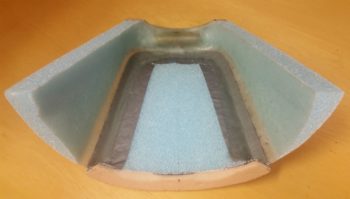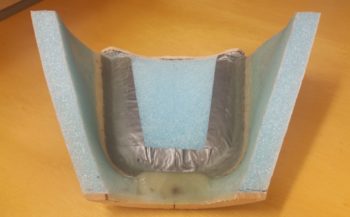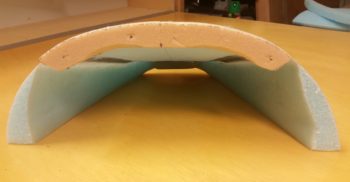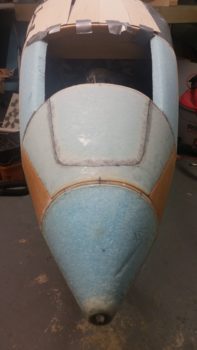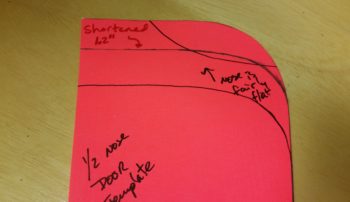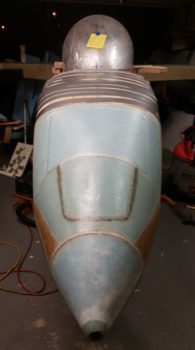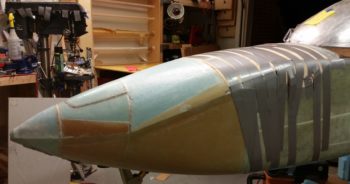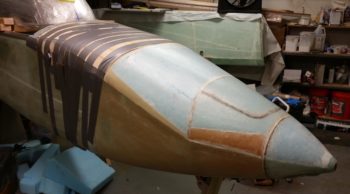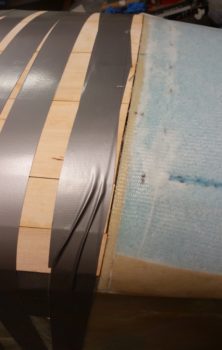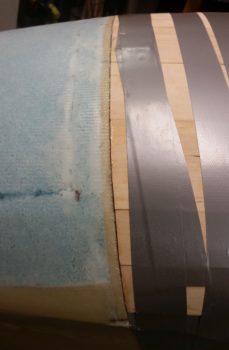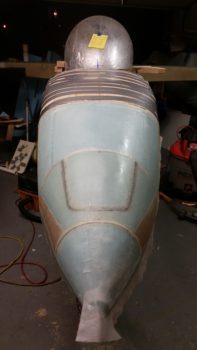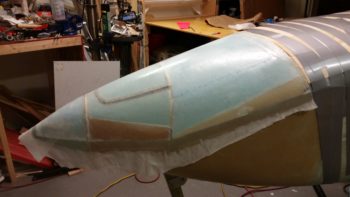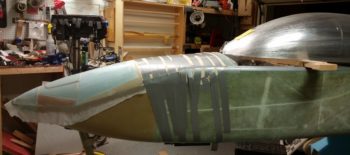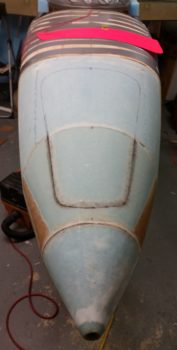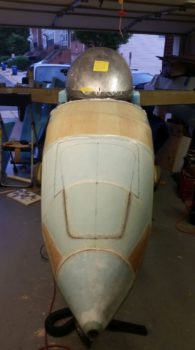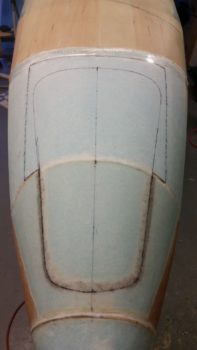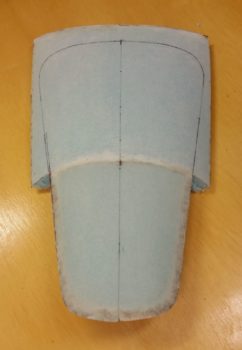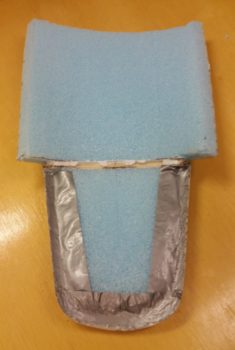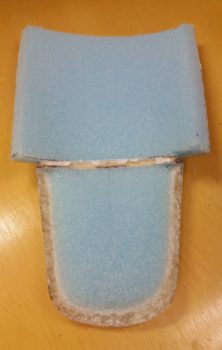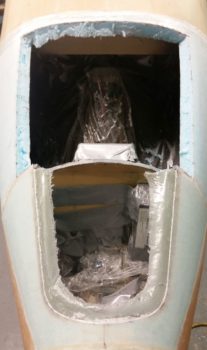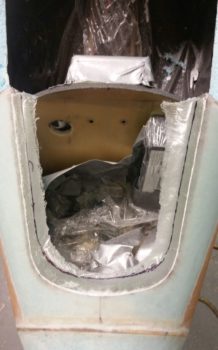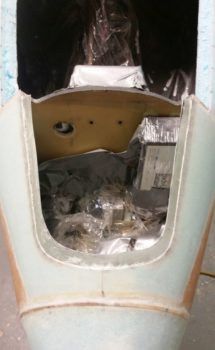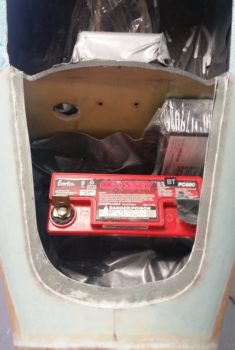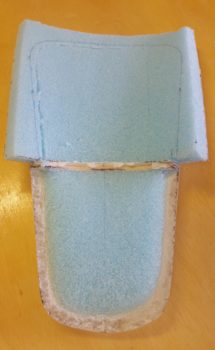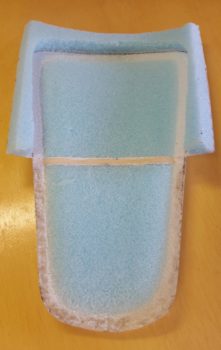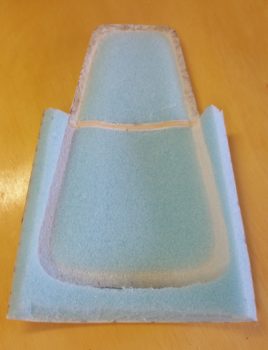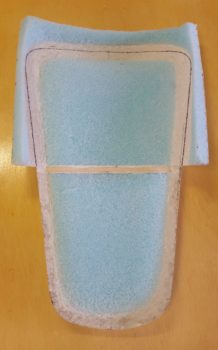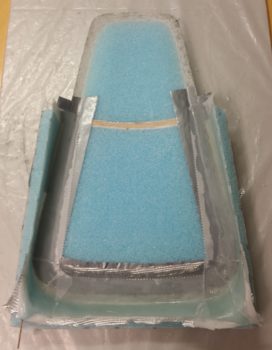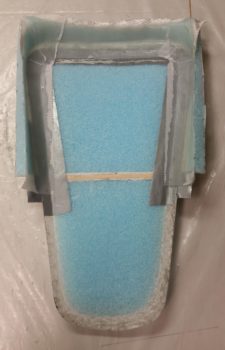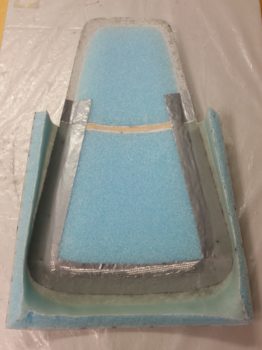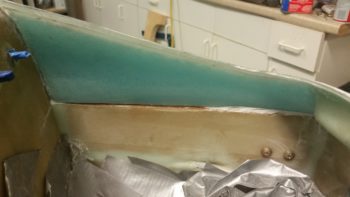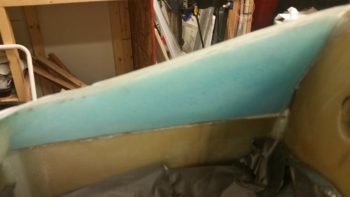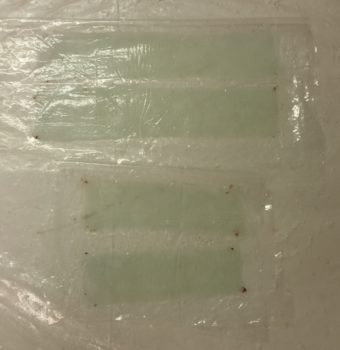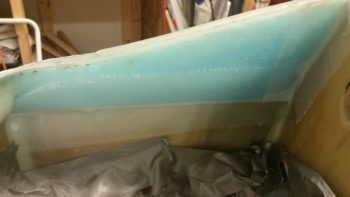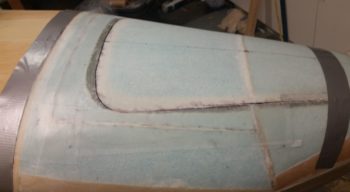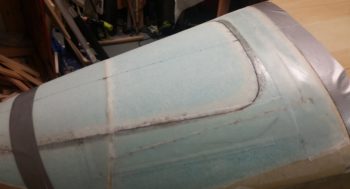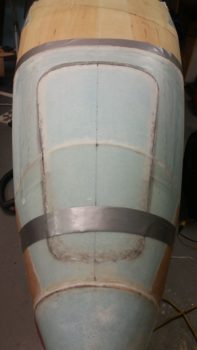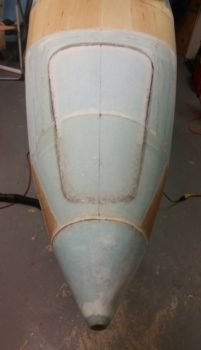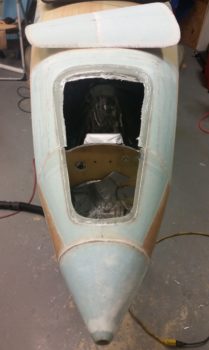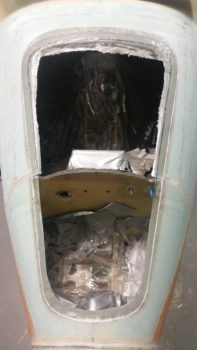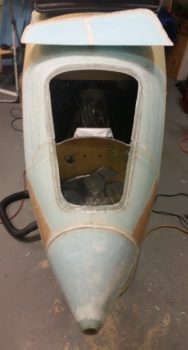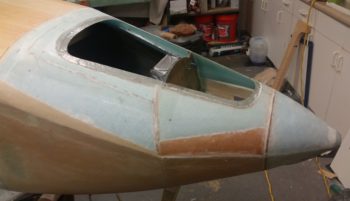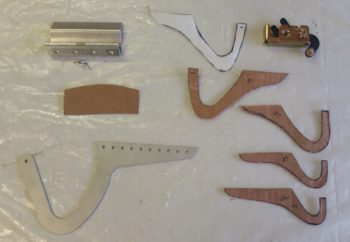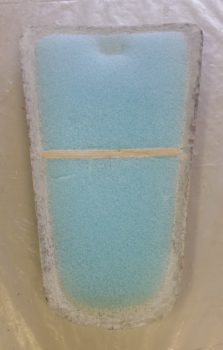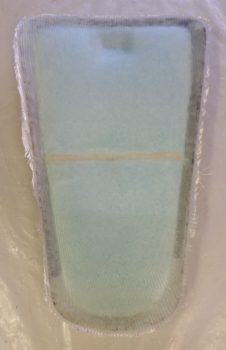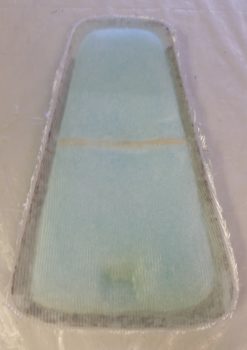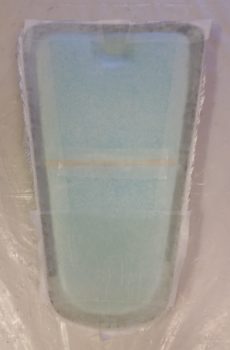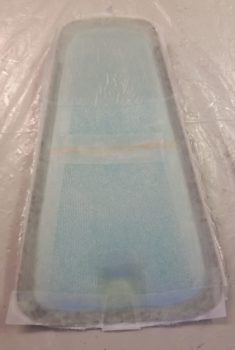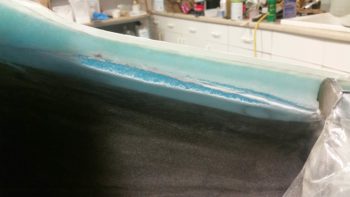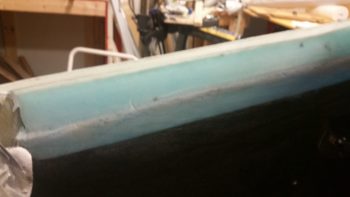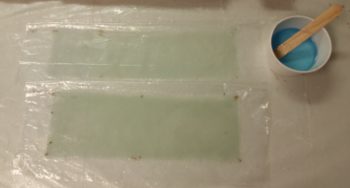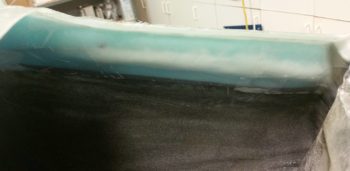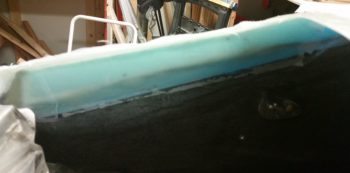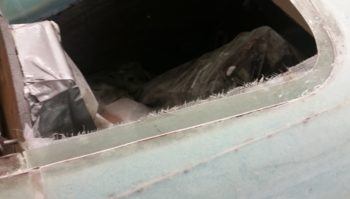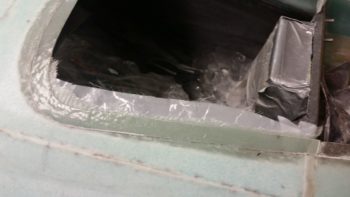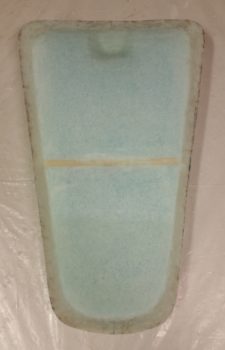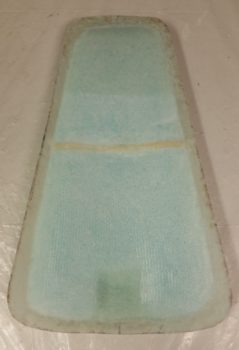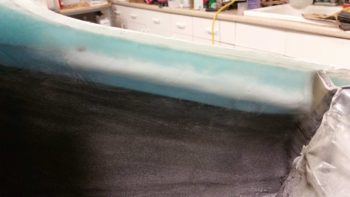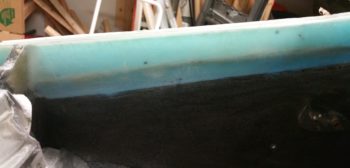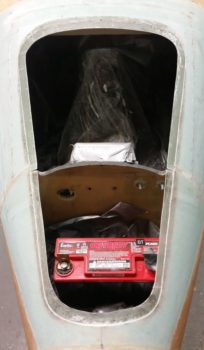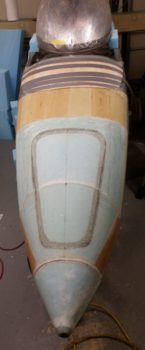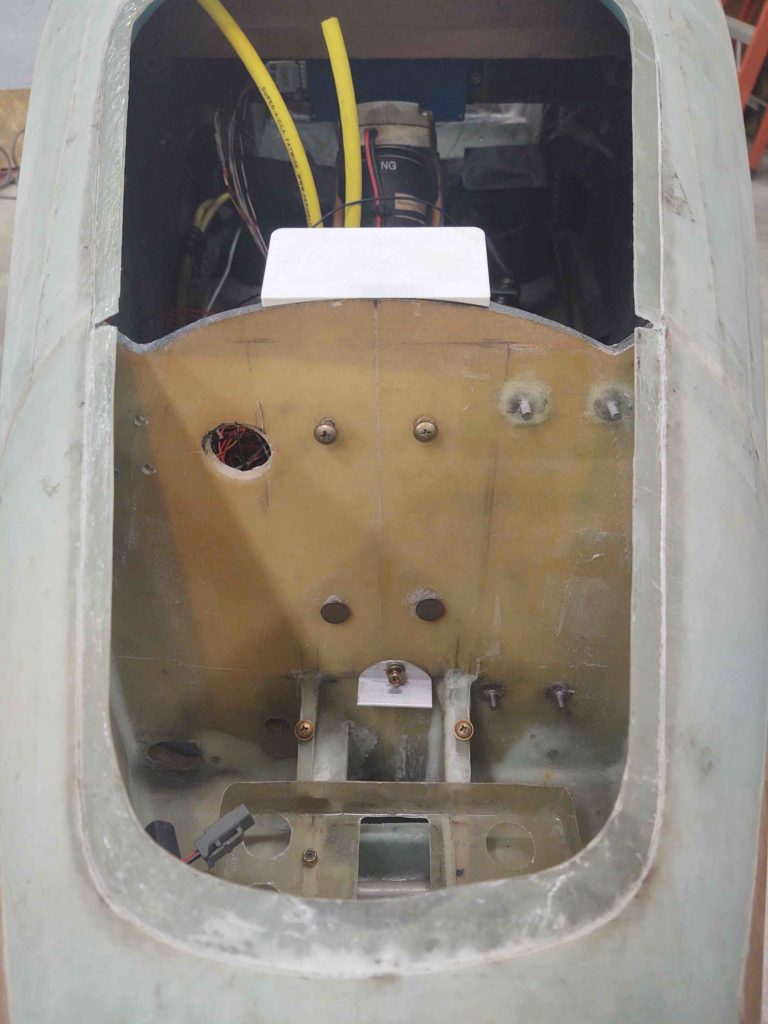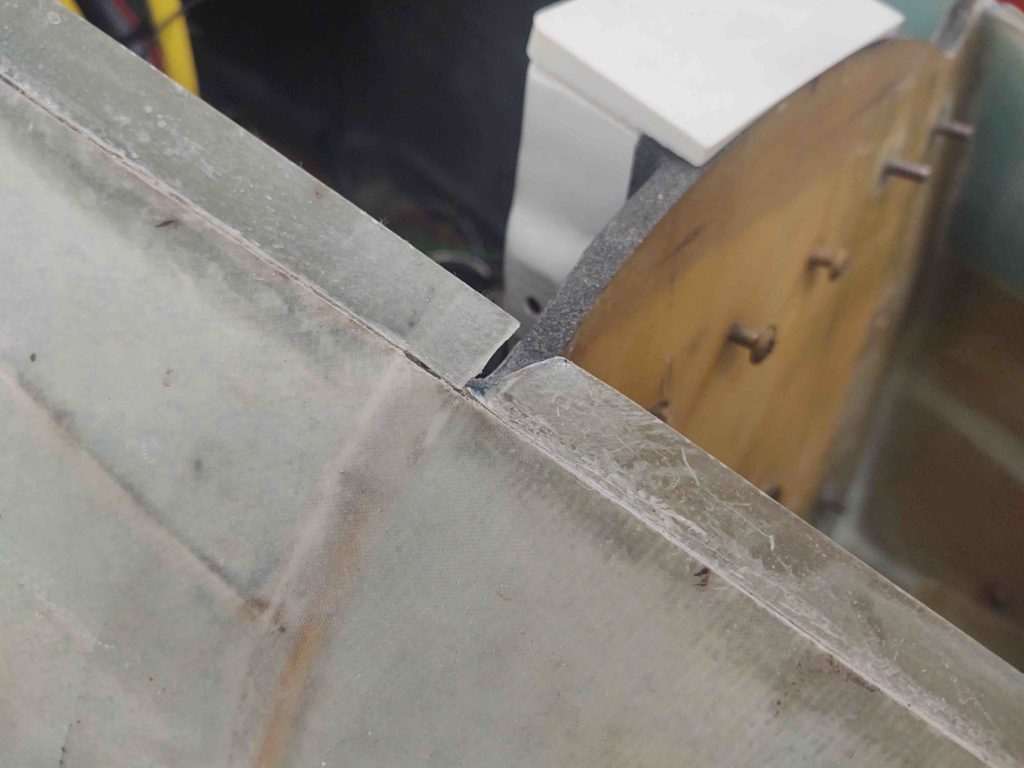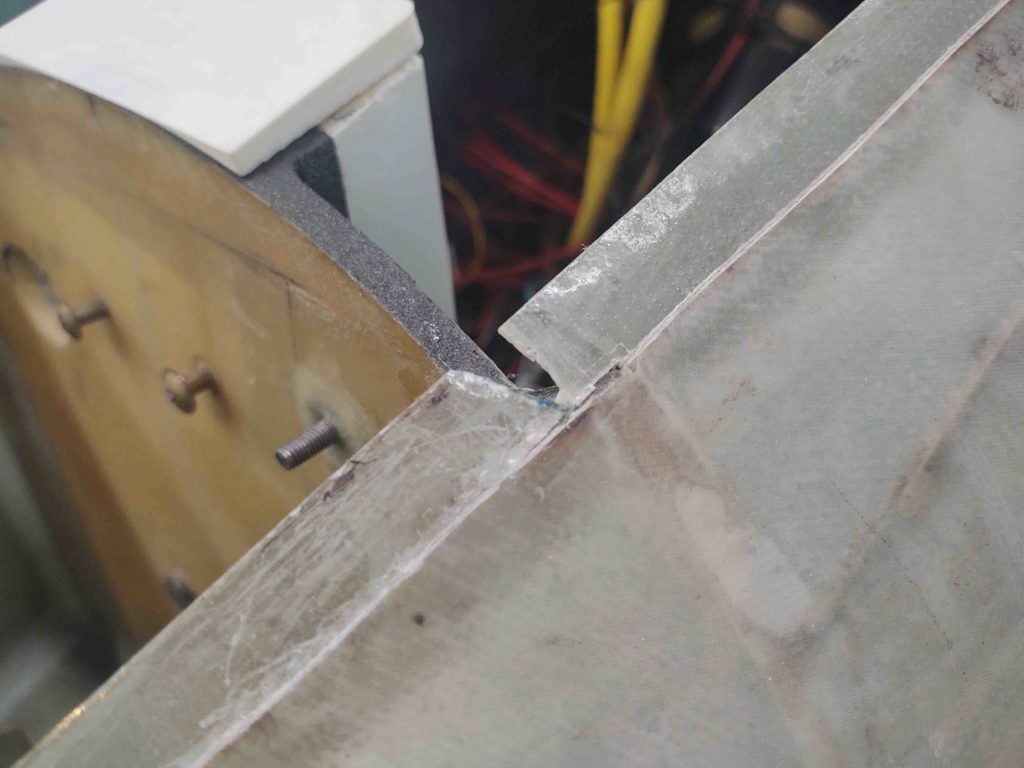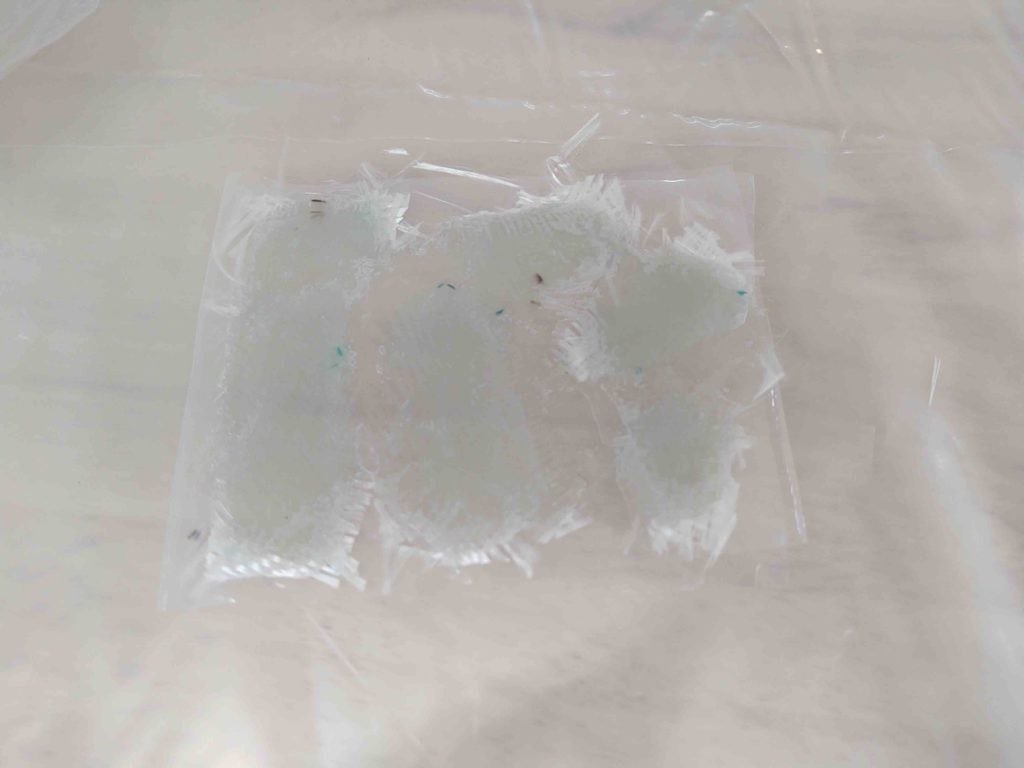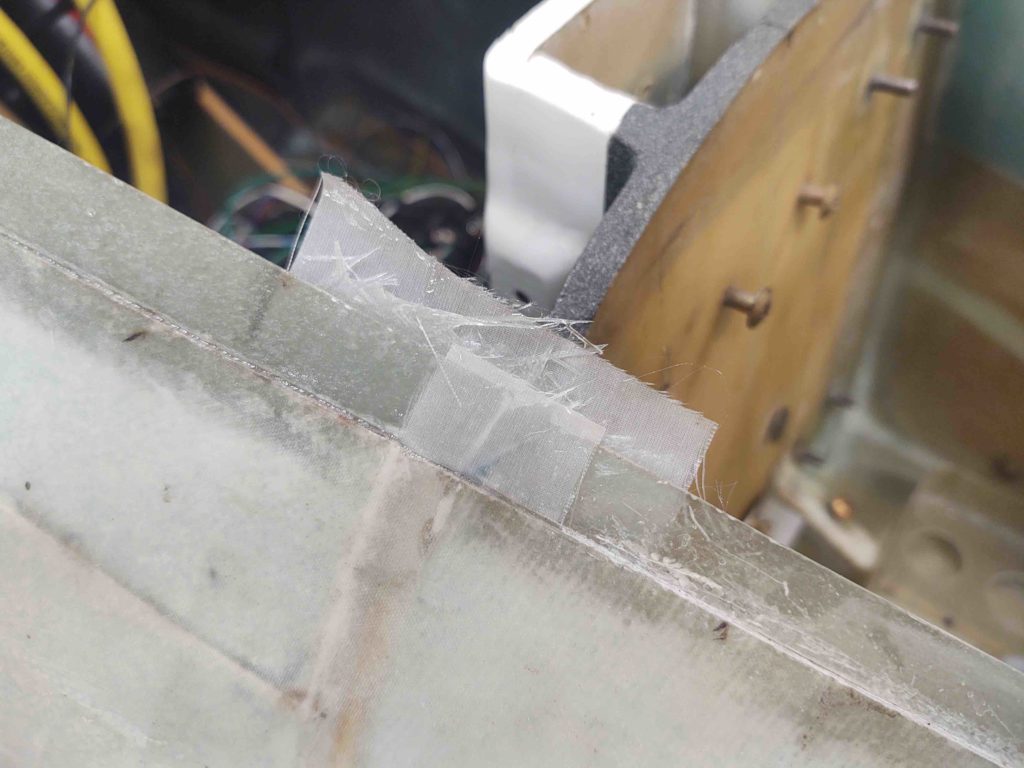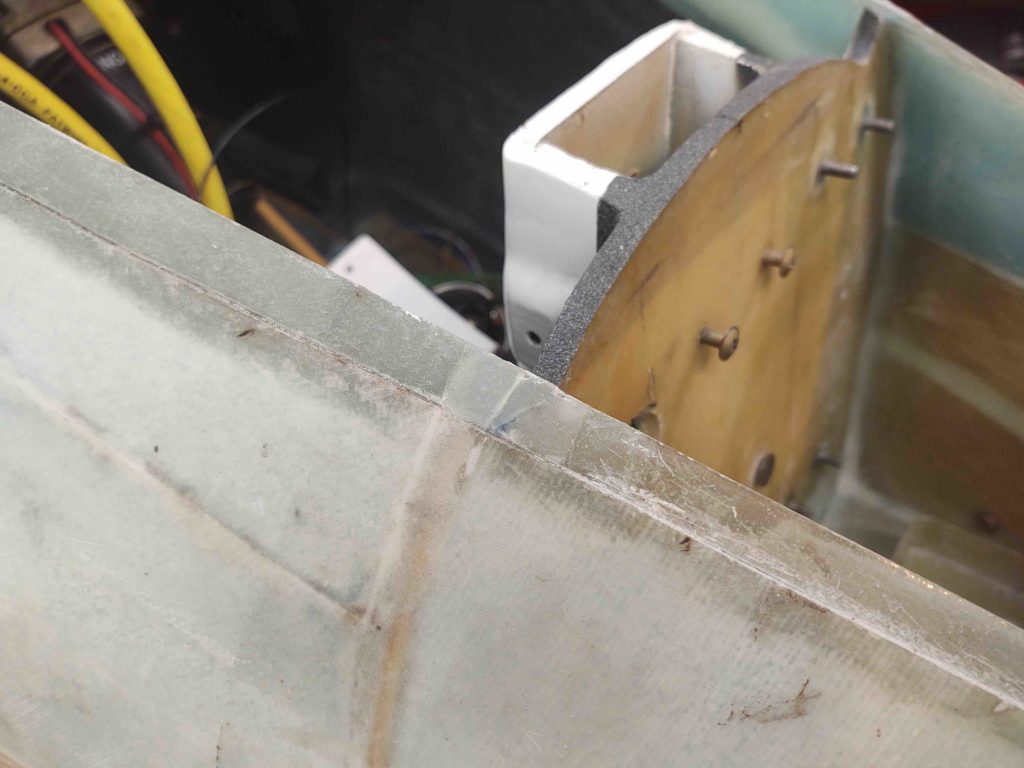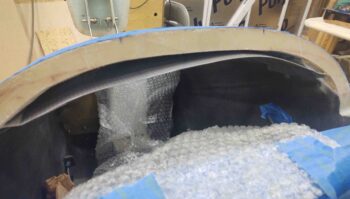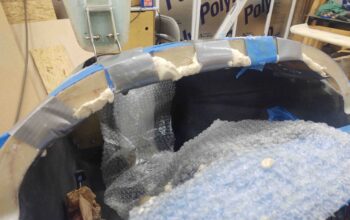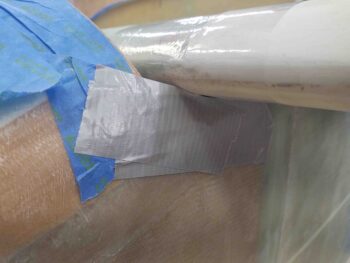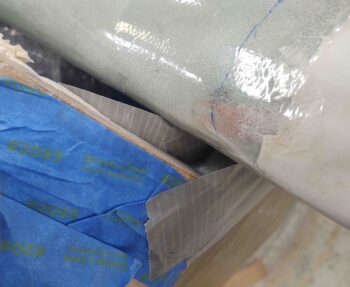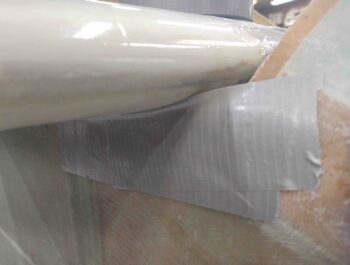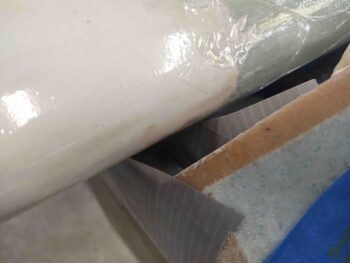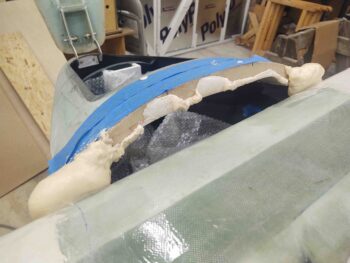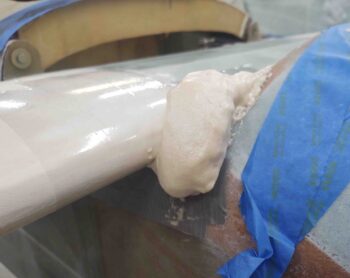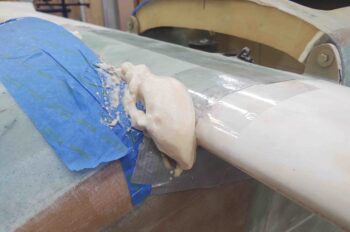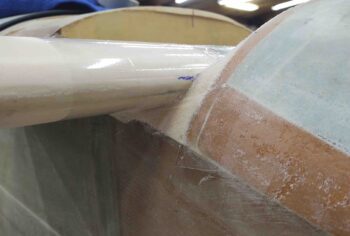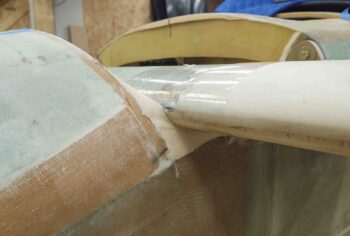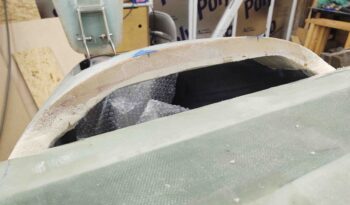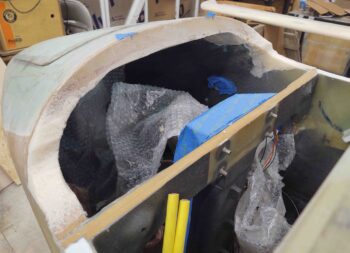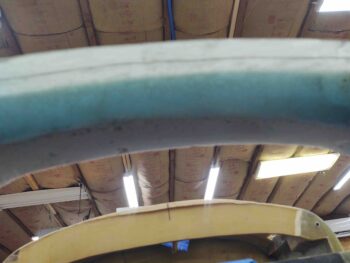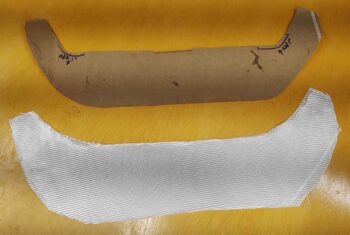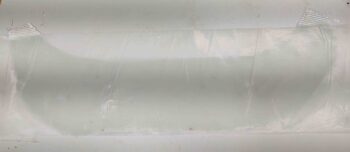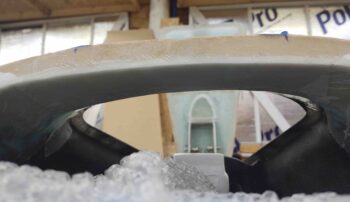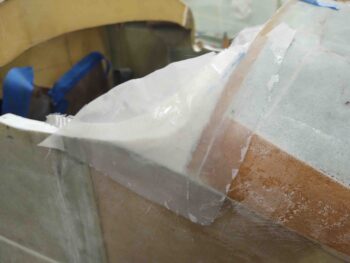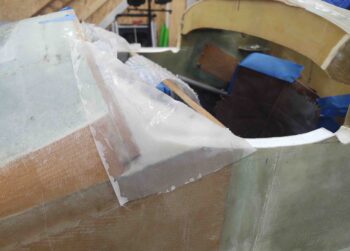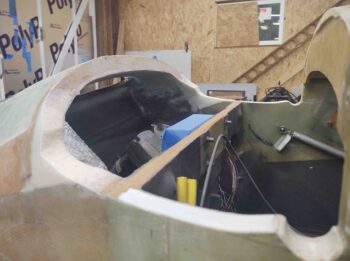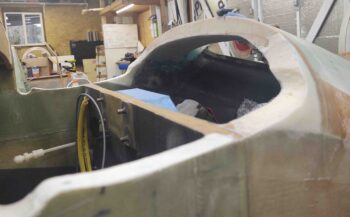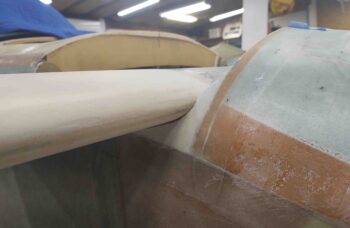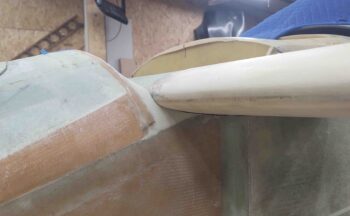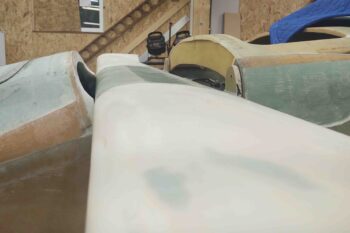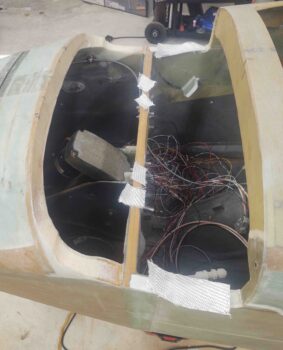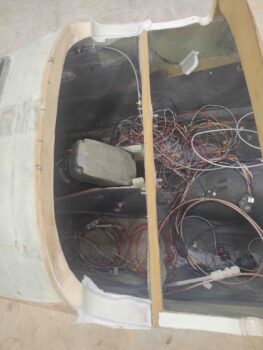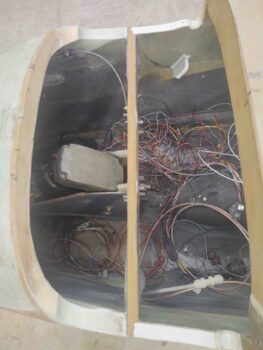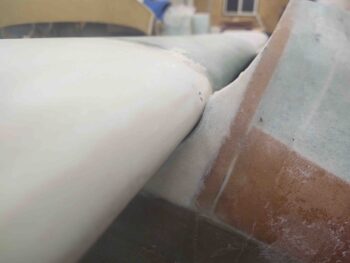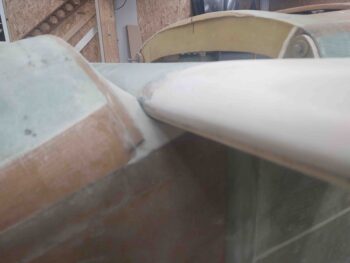Chapter 13 – Top Forward Nose Build
29 May 2018 — I started off today taking a gazillion more measurements, and checking out other builders’ sites on their canopy positioning and inboard elevator root fairings. After getting my comfort level significantly higher on the whole of the plan working (at least on paper!) I got to work cutting out some 3/8″ PVC foam.
The first piece was for an intermediate bulkhead that I’m going to install just forward of the canard, which will look bow-shaped and will essentially serve more as both as a bit higher strength cap to the blue foam going in forward of it, and as a demarcation point for the avionics bay/nose cover going aft.
And yes, you read that correctly.
I will be incorporating a flip-up/removable cover for the canard and avionics area forward of the instrument panel and aft of F28. It will also overlap the panel going aft so that the canopy will physically lock it into place when closed (that of course is not the only securing method on the aft side).
More on the avionics bay/nose cover below, for now here’s another view of the intermediate bulkhead that I’ll be securing into place before the nose foam is put in place.
I then took my wide roll of packing plastic and wrapped up the nose from tip to instrument panel to protect the innards from errant fiberglass, foam and other nasties.
In the summer of 2012 I glassed the exterior of the fuselage without having caught the requirement to round the very front of the longeron and nose sidewall foam, as you see that I’ve just done on the right side (left pic below) vs the way I had it (right pic below). Yes, I was living in blissful ignorance until Marco went to glass his fuselage, at which point he queried me about it. I gave him my incredibly well thought out reply of, “Huh?! What are you talking about?!” Followed a bit later by, “Ah, <enter appropriate expletive here!>” To see a great explanation of this, check out Marco’s blog.
So here’s my shaping the forward top longeron intersections with F28, with the right side (left side of pic) nearly finished and the left side still untouched.
•••
2 June 2018 — Today I got to work estimating the sides/corners and middle open area of the nose intermediate bulkhead. I started to cut the middle open area with the inside edges positioned much farther out before I reiterated to myself that there is a significant transition from the aft squarish-shaped nose cross-section to a much more round cross-section the further forward the nose goes. So I added some mass back in since most likely it is the outer “corners” that will get shaved off during the nose build process.
I then mocked up the intermediate bulkhead. Again, this intermediate bulkhead is the demarcation line in that everything forward of it is “standard” nose and everything aft of it lies under the aft nose/avionics top deck cover.
I then glassed the aft side of the intermediate bulkhead with 1 ply of BID and peel plied. If you’re wondering about the front side of the intermediate bulkhead, it stays in raw foam form since it will combine with other raw foam to make up the forward nose walls.
After pulling the peel ply and trimming up the layup on the intermediate bulkhead, I micro’d and glassed it to the nose sides using 2-ply BID tapes on both the front and aft corners.
Here’s another shot of the intermediate bulkhead (sorry for my POS camera!).
And here’s a wider angle shot showing the intermediate bulkhead glassed in place.
I had planned on doing a few more layups, but my better judgment actually won out tonight and said to break a littler earlier than I normally would. I’d be working on the avionics top deck area and I wouldn’t want to inadvertently hit the intermediate bulkhead while it’s curing. I have it spiked in place with toothpicks, and the measurement has stayed locked on like a laser sight, so I’m not going to mess around with a good thing.
•••
12 June 2018 — Today I started filling in the gaps on the top of the nose with foam. As you can see, I found a perfect candidate block of big blue foam to fill in the front top part of the battery compartment, which sits immediately forward of the Napster bulkhead.
Here’s a front view of 2 of the 3 nose sections filled in with foam…. obviously needing some shaping to be sure.
I then hit a decision point. Which at the time I didn’t specifically identify as a decision point, it just happened rather organically. I had a related twofold issue at hand, the latter associated with my overall nose issue, which I’ll address shortly.
The first issue with adding foam to the area between the Napster bulkhead and the intermediate bulkhead was actually rather self-induced, in that simply the angles on each end are acute (less than 90°) and so I simply couldn’t just drop a block of foam in from the top. I did realize that this would be an issue when I glassed in the intermediate bulkhead, but I still felt the positioning of the intermediate bulkhead and its configuration was the best option when I did it… and still do.
My solution was rather a simple one, fill in the corner between the intermediate bulkhead and the existing nose sidewall so that the angle on aft end of the last open (non-foamed) nose compartment was more than 90° (obtuse angle to be specific). Not that hard, so that was the plan.
However, as I collected up my leftover scraps of 2″ thick PVC foam from the original nose construction, I was thinking A) how best to utilize these scraps (underlying tenet here: I’m cheap!) and, B) how do I best configure the foam to ensure clearance for the pitch trim actuator bracket.
Ok, stay with me…. haha!
All this pondering led me back to the original overarching issue that I have with glassing the nose, which is part 2 of my twofold issue from above: constructing the nose hatch. You see, my Davenport nose design does not lend itself well to having just one nose hatch, but two. Why? Well, it’s all due to that devious little basterd, Napster! Having a bulkhead right in the middle of your hatch makes constructing one (at least for me) a bit problematic.
I say this because normally hatches in the nose (on Long-EZ’s anyway) are made by simply filling in the nose with foam, shaping the foam, glassing the resulting nose shape, marking up the hatch on the new glass, then cutting it all off! Then with the removed nose shaped block of foam you whittle away the inside foam till it looks like a contoured nose inside…. then cut out the hatch, glass the lip in place and the rest of the interior nose foam, and then using the new nose hatch hole glass the nose structure back on with BID tapes on the inside between existing nose and new interior nose structure. Ah, not too difficult, eh? Until a bulkhead is placed in the middle of all that!
So, to end the bleeding on this segment of my blog, I will just state that I resorted to my normal course of action regarding airplane building at this juncture: I decided to simply build from the inside out. It will most likely add a day or two to my nose build, but I will get what I have identified as my requirement: a single larger nose hatch.
Thus, instead of changing the angles between the intermediate bulkhead and Napster, I simply started building the sidewalls. My idea is to finish the INTERIOR nose just up the point surrounding the hatch, and then carefully work it in conjunction with the battery compartment side of the hatch.
I then shaped a long wedge piece of PVC foam to add onto the right nose wall.
And micro’d it in place, securing it with nails (and one screw).
Not having one solid matching piece to do the same on the left side, I cobbled some pieces of 2″ thick PVC foam together to then make close to the same structure as on the right. I then micro’d these pieces in place.
With the multitude of angles at play on these nose pieces, trying to fit one in place is both maddening and time consuming. One has to simply accept the fact that rarely will you get a solid block in there at one go, and at least one other piece will have to be added… either at the front or back. And often two pieces will be required: one front and one back. I was able to get a decent sized chunk of blue foam in place on the right side with ONLY one required added piece to fill in the gap on the back side.
I thought I had taken a previous shot of this foam piece before I rough shaped the nose foam bits, but apparently not.
Another shot of the foam on the nose, roughly shaped. The foam piece I added in the middle section on the right (left in pic) looks thick, but a good majority of that will be sanded away when I do the final nose contouring.
To alleviate some of the problem that I detailed above in creating one large nose hatch vs multiple hatches with a bulkhead in the middle, is exactly why Napster came into being in the first place. When I constructed the nose pieces back in 2013, I determined the width of my hatch and notched the top of the Napster bulkhead (I don’t even remember the actual nomenclature of this bulkhead!) to allow for the thickness of the hatch door.
Here I’ve created what is going to be a transition point from the forward battery compartment to the NG30 compartment using a piece of 3/8″ thick PVC foam. It’s Napster’s toupee if you will, and it will serve essentially as an embedded bulkhead in the structure of the nose hatch door. Before I cut this foam out, I taped up the indention on the top of the Bulkhead (Napster’s head) with 3 plies of thick Gorilla duct tape to build in clearance between the nose hatch door and the Napster bulkhead. This duct tape will also serve as a release agent when it comes time to remove the hatch door (remember, I won’t be pulling the entire nose structure off like is traditionally done in building nose hatches since I’m scratch building the nose hatch in situ.
In line with what I said above, here you can see that the interior edge of the foam that I’ve micro’d in thus far is contoured close to its final shape as it will be to make up the interior nose wall. After one more piece is added to the right side, I’ll do a final shaping of the interior foam and actually glass it with a ply of BID.
Here’s a closer shot. At this point the walls are 1″ thick, and they’ll most likely narrow to about 0.8″ thick towards the nose top.
My final push for the evening was to mirror the right side and get a decent sized chunk of blue foam micro’d in place on the left side of the nose. It turned out fairly well, although due to the angles when it was finally micro’d in place I realized that for all surfaces to be as close as possible in maximum strength and to minimize micro usage, that the thickness of the wall is about 1.35″ thick… so more sanding down of the interior wall will be required before final glassing (it would have anyway, but this will be a bit more aggressive sanding to start).
It was late so I didn’t trim down the exterior of the newly added piece of foam… even more so because the micro hadn’t cured yet. So after almost an hour of cleaning up the massive amounts of foam and dust in the shop, I called it a night.
Here’s a parting shot for the evening of the nose under construction. It will be fun to look back at the nose in its current hodge-podge state, all cobbled together, to what it will eventually end up looking like!
•••
13 June 2018 — I started out today by initially sanding down the shape of the nose in pic #1 on the left, then did round 2 as shown in the pic on the right. As you can probably tell I spent a fair bit of time sanding on the intermediate bulkhead’s “shoulders.”
After some quick thought I decided that to fill in the gaping hole in the middle of the nose I would use one big plug. Yes, I would account for the differences in the forward and aft angles, but I would start with 1 big foam plug.
I grabbed a good candidate piece of blue foam and marked a centerline on it.
I had just made up a cardboard template for both the front and aft sides of the hole I was attempting to fill. I then pinned the templates in place to the foam plug with nails.
I then cut the sides of my foam plug which gave me a big block of blue foam to start my adventures with!
I then did a test fit and realized that this might take a while. Plus I was thinking, “Do I really want to go this route . . . eh, what the heck, let’s give ‘er a try!”
A side shot after a bit more finagling and a lot of cutting and sanding.
Looking a little bit better . . . at least it’s not so proud.
Ahhh, now we’re getting somewhere!
Now, as I mentioned yesterday, with these angles there needs to be some relief somewhere, so I had about a 1.5″ strip on the back side that I would then simply fill in with another strip of foam.
Which is exactly what I did!
Here you can see the main plug and the smaller gap filler piece in the back.
With all the dimensions, angles and fit looking pretty good on my foam filler plug pieces, I then set them in place and started hacking away with a wood saw.
Here’s the final result of my Neanderthal shenanigans with the wood saw.
I then got serious and used the long board to get a final shape of my nose! hoo-ah!
Here’s a couple profile pics of my new nose job!
And a more formal pic after I cleaned up the shop and straightened the canopy (ahem!) up.
And a quarter angle shot. You might notice where it tends to flatten out just a hair around the Napster bulkhead. Minor variances like this will of course be mitigated during the surface micro finishing process.
I then grabbed a line to quickly lay out the nose center line.
And then set the nose hatch template half in place. I think this will be a great size and shape for the nose hatch.
And AFTER I set it in the position I wanted from front to back, I checked the notch on Napster to see if I had determined it correctly (remember, it’s a bit tricky since the bulkhead is curved!)…. but I was well within 0.1″ on each side. Not bad!
After I spent a little bit of time sanding the surface of the battery compartment foam nose piece just a bit to ensure a ply of UNI would bring it back up to level with the rest of the nose, I then removed it from the nose and vacuumed it for a layup.
I then micro slurried the foam and laid up 1 ply of UNI with the threads going from side to side. I then peel plied the layup.
I laid up a ply of glass on this piece because I will actually carve it out and glass the interior sidewalls before mounting it onto the nose for good. Then when I create the nose hatch I can just lay up BID tapes on the inside to secure this foam piece in place as far as internal layups are concerned.
I then spent a little bit of time sanding the interior of the nose sidewalls that I micro’d into place. Once they were to my liking, I then vacuumed out the interior of the nose and the foam in prep for glass. I also test fitted the RCU (Nose gear Relay Control Unit) –in the box that Marco 3D printed for me– to ensure that it fit with the new sidewall in place. As you can see, it fit with room to spare. I guess I did ok on the box dimensions! (grin)
I then laid up 2 plies of BID on the right nose sidewall’s new foam, overlapping about an inch onto the existing sidewall glass on the bottom, and the same in the front corner where the glass overlapped onto the aft side of Napster.
I then peel plied a 2″ strip along the top, the front and aft edges, and an inch wide along the bottom.
I then reloaded and repeated the same process for the left side new nose sidewall foam. Both layups turned out pretty good even though the foam underneath wasn’t perfect.
•••
14 June 2018 — I started out by pulling the peel ply and trimming the glass edges on the nose battery compartment section cover. I test fit it back in place and it still fits like a champ.
I then pulled the peel ply and trimmed the glass edges on the left and right interior nose sidewall extensions layups. I cleaned up all the peel ply boogers and inspected the layups.
The layups themselves looked good and were of good quality, but I couldn’t get past the menagerie of varying colors, foam types, etc. I simply did not want that staring me in the face every time I opened the nose hatch. And I checked to see if these sides would be visible with the hatch open, and from what I could ascertain in my mental mockup it was a definite yes.
Since I already had a plastic cover in place to protect the nose components from all the nasties produced during the construction of the nose, I simply pulled the sides and move the tape line to just below the existing visible speckled paint I had shot before. I then spent about 10-15 minutes adding a bit more protective barrier and tape, including the top side edges of the new foam sidewalls that I had just glassed.
I then hit the just-glassed interior nose sidewalls with a light coat of primer and a couple light coats of speckled paint. Ahhh, HUGE improvement. So, so, so much better!
I then remounted the pitch trim actuator bracket… if you compare this pic to the one above of the same sidewall…. wow, no contest. I’m very glad I decided to take a half hour to remedy those eyesores!
I actually did a bunch of the following while the primer from my painting effort above dried, at which point I took a couple minutes to shoot the final speckled coats.
I measured the current sidewall widths both at the front and aft ends to then transcribe those sidewall widths onto the bottom of the nose battery compartment foam cover piece.
I then marked up the sidewall widths going up, as you can see on the aft side of the foam base of the cover here.
I then started dishing out the extra foam on the bottom side of the nose battery compartment cover. As a point of note and as I explained a couple of blogs ago, this step would normally be done AFTER the entire nose had been glassed and the builder was shaping the internal side/top wall of the nose to then create the edges in regards to the hatch. Again, due to the bulkhead in the middle (Napster) I’m doing all this before I glass the entire nose.
I then got to the final rough stage of foam removal on the nose battery compartment cover.
And then did a final sanding to smooth out the interior walls/top.
I then put the IBBS in its mounted position to check for not only clearance with the interior nose battery compartment cover walls, but enough space to mount and unmount the IBBS unit.
The black dot is where I marked a slight indentation from the corner of the IBBS pressing into the nose battery compartment cover interior foam surface. I then marked an area around the contact point to give the IBBS a bit more room for ingress/egress if required.
I then carved/sanded the clearance required for the IBBS unit.
I then marked up the forward dimensions of the nose hatch door onto both the exterior (glass) and interior (foam) surfaces of the nose battery compartment cover. I realize the nose hatch outline looks a bit off center in the pic below, but it must be an illusion created by the camera angle, because I rechecked all the dimensions from centerline and it’s both asymmetric overall and equidistant from the centerline.
I also carved out a small notch at the very front of the nose battery compartment cover to then insert a small piece of H250 high density foam. Since I’ll have only one larger nose hatch that is attached via hinges at the front end and by one latch at the aft end, I want to ensure the front side is very securely fastened and the darn thing doesn’t blow off the aircraft, thus the high density foam plug insert at the front edge for added strength. It may be a bit of overkill, but I’d rather not wonder about the security of my nose hatch door!
I then had to angle the bottom edge of the H250 high density hinge attach hard point so that it was pretty much level and parallel with the waterline of the aircraft.
Since I carved away the nose hatch marking on the foam, I wanted to check exactly where the nose hatch edge line was, so I took the piece outside to check it out in the sun. I could actually see the line in the shop, but thought this was a cool pic once I took it.
I then carved both the nose hatch door foam and the adjacent nose battery compartment cover interior foam down to create a gradual slope to where a lip will be created for the nose hatch door. Now, I’m not really concerned about the actual nose hatch door foam here, since it will get its final shaping done when connected to the aft 2/3rds of the nose hatch door which will be positioned aft of the Napster bulkhead.
My main concern here was the nose battery compartment cover interior foam, both the transition of the foam and the width, position and quality of the glass along the foam edge. I had meant not to micro the foam when laying up the 1 ply of UNI on the external side of the foam, but didn’t remember until immediately after I had slathered on all the micro.
Thus, with a really rough surface to contend with, I took the piece out back and spent 15 minutes with the Dremel Tool carefully knocking off all the micro crud from the glass. I then sanded it smooth with a Perma-A-Grit tool and called the glass surface acceptable for a glass-to-glass bond.
Since there is not a lot of sidewall here on each side of the nose hatch door opening, I opted to add another ply of BID to each side for added strength. It’s not like there’s that much real estate to really make a huge impact on weight, and I figure this is also somewhat of a structural area simply in regards to the nose structure as a whole, and specifically for the constant swinging action of opening and closing a rather large nose hatch door. I also added a couple of rectangular plies just over the H250 high density foam hinge mounting hard point.
The methodology that I’m employing here is that I am simply creating the lip of the nose hatch door now vs later. The 3-ply nose battery compartment cover sidewall glass simply crosses and is glassed to the narrow bare glass threshold to then overlap onto the taped foam surface of the nose hatch door. To be clear, the line for the nose hatch door goes pretty much down the center of this bare glass threshold.
The KEY to ALL of this is that when I cut the line for the forward side of the nose hatch door, I must be very careful and cut just through the top glass and not all the way through… which would negate all the work here and I would simply lop off the lip I have just created. As insurance I added another ply of BID around 1/2″ wide to just below the nose hatch door outline.
I then of course peel plied the edges of the layup.
While the internal nose battery compartment cover layup cured, I then got to work on the what will be the back “half” of the nose hatch. I will work this side of the nose hatch in a more traditional manner in that I will remove a piece of the nose with a few added inches around the marked nose hatch line, create the edge of the nose hatch hole & door, glass the piece, then return it to the nose for final glassing.
To do what I just described I’m essentially just removing the big center foam nose plug I created yesterday. Yes, I know it’s better for bonding to glass multiple plies of glass all in one go, but here I don’t really have a choice (as I see it) if I want to make this single larger nose hatch a reality. Thus, I won’t even micro in the big center foam nose plug when I lay up the initial single ply of BID on the nose. I will simply mark the edges with a Sharpie to make it visible and then cut it out once the glass has cured. When I do cut out this big center foam nose plug, I will also CAREFULLY cut out the then attached forward nose hatch door piece from the nose battery compartment cover. It will probably look like a big blob of glassed foam with a giant fingernail sticking out!
To set myself up to make all this as easy as possibly, I wanted to dial in the general shape of the interior of the big center foam nose plug. I determined the widths of the adjoining sidewalls and marked them up on the foam plug.
I then removed all the extra foam and rough shaped the underside of the big center foam nose plug.
And then hit it with a round sanding block to get a smooth surface on the underside, which besides the required depressions for the edge of the nose hatch, completes the major foam shaping –both internal and external— for the nose!
Here’s a view of the big center foam nose plug right side up.
I then of course test fitted the freshly carved (underside) of the big center foam nose plug. Looks like it will work (fingers crossed!) . . .
It was very late so I did one final push for the evening to finalize the preparations for both the front and aft side nose sections for glass. By this point the internal nose battery compartment cover layup had cured. Not 100% (thankfully!) and was still just pliable enough for me to razor trim the edges with a knife. I also pulled the peel ply and cleaned up the edges and all the peel ply boogers.
The layup looked really good and looks like it will work according to plan. Here’s an internal shot of how it will look from the aft side once it’s installed in place.
I then of course had to test fit it back in its place on the nose.
Looking pretty good!
•••
15 June 2018 — I started off the day by taking a piece of paper and drawing a line down the center horizontally to create 2 panels. On the top I drew out my front nose layup and all the associated tasks for completing that layup. On the bottom I drew out the aft nose cover layup/construction and all the associated tasks for that endeavor. Then, with it on a clip board downstairs I added a a few more points to watch out for and another few tasks as I was thinking about my upcoming layups as I cleaned and organized the shop.
I started with the aft nose cover structure and then set my sights on the front half of the nose. I spent some time assessing the nose hatch and the required components that would be mounted in, near and around it. I realized that with the nose hatch latch installed, along with the hinge mounts for the aft nose/avionics top deck cover, that I just didn’t have enough nose real estate on the aft side of the hatch. In short, the hatch was just too long and was eating up too much precious real estate on the inside of the nose in the area between the hatch and the aft cover. I simply had to shorten the hatch length.
I spent another 10 minutes assessing the space required, and then ascertained that if I lop of 1.2″ off the aft end of the hatch that I could most likely squeeze all I needed to in the area between aft cover and front nose hatch.
I then got busy glassing the front side of the nose.
After the requisite sanding down the edges of the existing glass for smoother glass transition, and angling the sides of Napster just a hair, I then micro’d/floxed the battery compartment/front hatch structure into place.
It’s always a point of amusement, or at least interesting I guess, that the majority of the glassing process is applying the micro to the foam surface! It’s amazing how long it takes compared to the actual process of putting the glass in place and wetting it out . . .
Nonetheless, rest assured micro was applied to all bare foam and then I laid up 1 ply of BID on the entire forward nose structure, overlapping onto the existing glass the requisite 1 inch.
I grabbed these shots from both the left and right sides of the front nose vs aft nose cover intersection. This will be the one visible line that traverses across the nose other than the nose hatch door outline.
I then peel plied the entire forward nose layup. Earlier I had considered laying up the 2 plies of BID prior to cutting out the nose hatch, but then decided against it since that would then require using only BID tapes to re-secure the aft nose hatch structure when I glass it back into the nose after creating the interior nose hatch perimeter on the underside/interior of the nose structure. Nope, as much as I don’t like splitting up layups, the nose was getting only 1 ply of BID at this point…. so peel ply it is.
A couple more side shots of the peel plied forward nose layup.
And a wide angle shot showing the profile of the nose. I really am loving the shape of this nose, and it’s incredible how long and narrow it looks without the canard installed to break it up.
•••
16 June 2018 — Today I pulled the peel ply off the nose and then cleaned it up.
Then just before turning out the lights in the shop, I did an initial markup of nose hatch just out of curiosity. Here it is:
•••
17 June 2018 — I started on the forward nose this evening by marking the perimeter of the foam plug around the back half nose hatch.
Before it got too late to make noise, I grabbed my Fein Saw and cut the perimeter of the front nose hatch door –NOT TOO DEEP!!– and then all the way through on the back half foam plug.
I then carefully removed the nose hatch door with the associated & attached foam plug on the back half of this odd piece. Hmm, this does resemble something? … Oh, yeah, a fingernail! . . . just like I predicted!
Here we have the underside of the nose hatch door. I will essentially create the edge of the back half of the nose hatch as I did the front half.
I then removed the duct tape from the underside edge of the nose front hatch door. I have to say I’m really happy with how my single larger nose hatch door plan turned out!
And here is the nose hatch in its current state… with the outline of the foam plug on the aft end visible.
I then marked the cut line on the perimeter of the forward nose hatch flange to trim it down to a narrower, workable width.
Again, I grabbed my Fein saw and within a few minutes had a nice trimmed flange for the front half of the nose hatch door.
•••
18 June 2018 — Since I didn’t have enough BID on hand to glass the canopy, I made today all about finishing up as much as I could on the nose.
I will say that –except for 1 external ply of BID (or perhaps 2 plies of UNI) and 3 BID tapes– the nose structure is FINISHED!
I started off the day with a quick check to see how the battery fit inside the nose compartment. It fit like a champ and the only issue is the fact that to put the battery in or take it out I’ll have to remove the tool box. No biggie really.
I then got to work on the nose hatch and the adjacent foam structure on the aft end that in reality is part of the nose structure of the aircraft, not the hatch’s.
I started off by identifying where the hatch outline was and then started cutting and digging out foam.
I got the hatch door cover side of the foam removed and the hatch outline door/opening line exposed, and some of the aft door foam shaped to match the front half foam. Note that I trimmed down the little mini-bulkhead that had been in place as a sort of a template atop Napster’s head.
I really had some thinking to do and some decisions to make regarding the nose hatch, and specifically the adjacent foam structure…. as you can see, I didn’t leave myself much space at all to work with. I knew this going in after I had mounted the nose sidewall pieces into place in the area between the intermediate bulkhead and Napster, but I thought it would be tight, but workable.
I considered cutting the bottom of the nose sidewalls to allow me to have a flatter approach on the nose side of the foam adjacent to the hatch door. But then I asked myself why?
A few mental walk-throughs with the hatch assembly in hand told me that the only operational impact that having steep sides adjacent to the nose hatch door was that it looked different than the convention. I could still make the steeper sides work, and I wasn’t impinging on anything within my nose. Not to be Mr. Snarky, but I realized the only thing I would be impinging on is the standard that I’ve seen on a lot of canard nose hatches. So, I pressed forward!
Now, the edge of the hatch opening on nose side in the few inches just forward of the rounded corner is fairly narrow, around 0.2″. So I decided that instead of laying up the glass in an “L” shape coming off the sidewall, and trying to get a good glass-to-glass bond at the inside corner of the “L” shape, that I would just layup 2 flat strips of BID first with the edge of the glass nice and snug up to the edge of the foam. Then I laid up 2 plies of BID coming off the foam side wall in a standard “L” shape. Along the aft side of the nose hatch I went the standard 3 plies of BID and then in the corners I added an extra ply that overlapped quite a bit both inwards and forwards, giving the narrow edge areas an extra ply.
I then of course peel plied the layups since these edges will get BID tapes to secure them to the interior walls of the nose.
A number of hours later, I pulled the peel ply and cleaned up the layup. The layup looked good and I felt confident that it was cured enough to get reinstalled into the nose.
However, to give the glassed nose hatch assembly just a little bit more time to cure, I then got to work laying up the BID tapes in the nose battery compartment. As I mentioned at the beginning of the post, knocking these out would knock one more structure to-do item off the list in getting the nose pert near done.
Here’s some before shots of each side inside the nose battery compartment.
I then cut some glass and set up some prepreg assemblies for the BID tapes. I then mixed up some epoxy and wetted out the glass.
After applying flox fillets in the corners and filling some gaps in the seams, I then laid up the BID tapes. I then peel plied the BID tapes and left the layups alone to cure.
After finishing up with the BID tapes, it was time to micro, flox and glass the nose hatch and adjacent structure back into place in the nose. I used micro on the foam and flox in the small seam on each side of the hatch on the aft side of what would be Napster’s ears.
I then laid up a 1-ply BID tape on the top and each side of the hatch door adjacent structure (plug) that had been removed along with the nose hatch door . . . the layups overlapping onto the nose skin of course. I then peel plied the layup in preparation for the one final layup that the nose will get.
•••
19 June 2018 — Today was all about packing up for my next load down to North Carolina, but I of course had to see how the nose turned out.
I spent about 15 minutes pulling peel ply and cleaning up the nose. The layups looked good without any issues.
I then carefully cut the perimeter of the aft side of the nose hatch door, but apparently not as carefully as the front half because I broke through on about 4″ on the right side. When I glass the underside BID tapes on the right I’ll simply add a ply and extend up underneath the flange. In fact, although I won’t add an extra ply, I’ll do the same on the aft side and the left side.
I then marked up the raw glass flange for a trim.
And then trimmed the aft side flange up with the Fein saw. I may not have pointed it out when I discussed the flange layup on the aft half of the nose hatch door, but part of that layup was an extension of the flange across the Napster bulkhead forward. These flange extensions turned out nicely, and later I’ll bridge the aft flange extensions to the forward side flange to make it all one solid flange around the entire perimeter of the nose hatch opening.
I then grabbed a quick side view. A few hours later I went down to the shop to grab something, and decided to take about 15 minutes to clean up the peel ply boogers and edges from the battery compartment BID tape layups, so those are all clean and spiffy now as well.
•••
28 June 2018 — Today I started out in pretty much pure research mode since I felt that before I could glass in the interior skin of the nose hatch I needed to have a good understanding of what was getting attached to it both hinge and latch wise.
After checking out a myriad of other builders’ blogs, etc, I headed down to the shop with some ideas to test out. One idea in particular is that Nate Mullins is using a spring-loaded hinge that was designed for a cowling oil dipstick access door, but he repurposed it for the nose hatch.
I have one of those hinges that I bought for the cowling oil dipstick access door, but for the nose hatch I liked the idea of having a narrow depth on the hinge and getting it out of the way. I tested it out a bit and realized that there was just no way it was going to work since my configuration is much different at the front of the nose hatch than what Nate has…. so I went back to the traditional hatch door hinge that we tend to use a lot in the canard world. I have a template that I traced from a hinge template that Beagle sent me, that –like the nose hatch– is actually for a Berkut. This hinge design is significantly smaller than the ones the Cozy Girrrls sell, which I have BTW and will be using on the aft nose cover.
After messing around with the configuration and testing different scaled sizes of this hinge, I finally came to the conclusion that the hinge pivot point must be as far forward as I can get it in the battery compartment, and the best size is the original size that I have from the template. Moreover, with that knowledge in hand I now know that I will have to do some major rework on my interior top nose structure to get the hinges mounted in there, so I’m going to let ideas of just how to install the hinge pivot points germinate in my brain a bit.
After confirming the position of the nose hatch aft latch, I then got to work on doing a final shaping of the nose hatch interior foam.
I then glassed the interior nose hatch skin.
After laying up a ply of BID in the aft latch depression and across the front for more strength for the nose hatch securing components, I then laid up a ply of UNI followed by a ply of BID.
I then peel plied a good majority of the layup.
As the nose hatch cured, I then got busy on the top interior nose side walls, where the aft nose hatch perimeter flange is micro’d to the top of the side walls. The angle between the bottom existing sidewalls and the new nose hatch perimeter flange piece added in is a bit sharper than I wanted, especially on the left side.
I Dremeled away all the excess micro and then sanded the inboard protruding intersection of the nose hatch perimeter flange with the top nose sidewalls.
NOTE: I won’t be messing around with the aft flange edge of the nose hatch since I need to prep the intermediate bulkhead area for securing the aft nose cover. I’ll wait until all the urethane foam in-between F28 and the intermediate bulkhead –that I used as a mold/plug for the aft nose cover– is removed and access that area from the F22 area of the nose.
As I said before, since I broke through the glass on the right side about 4-5″ while I was extracting the aft hatch from the perimeter flange, I added a ply of BID for a total of 3 plies on the right hand side of the nose. This BID will connect the existing nose sidewall to the added perimeter flange piece, and specifically add more plies to the flange itself. On the left side I’m simply using 2 plies of BID in the BID tape. Also, as you can see I prepregged the BID.
I then laid up the prepregged BID tapes on both the left and right side top nose sidewalls. I then peel plied the layups.
Here’s a shot of the glass peaking out from under the aft side nose hatch perimeter flange on both the left and right sides.
With the top interior nose wall layups completed, I then checked the nose hatch layup. The glass was cured about 80-90%, which was perfect for pulling peel ply and then razor trimming the edges of the layup.
The interior nose skin layup looked good and I didn’t see any issues with it!
•••
29 June 2018 — I started off today by pulling peel ply and trimming up the overhanging glass on the top interior nose layups I did last night. These layups really helped to reinforce the nose hatch flange and made the overhanging flanges stiff & strong.
I then took a few minutes to do a quick clean up job on the nose hatch flange itself.
Although this pic is a bit out of sequence, note the glassed nose hatch still fits like a charm.
•••
20 August 2020 — The first task today was to fill in the gaps created by my wild and wonderful method <grin> of glassing the nose to give me the hatch opening I have. Since it was actually glassed in multiple steps, using Napster as the line of demarcation between front and aft sections of the nose hatch, the resulting nose hatch perimeter flange has a gap in the glass on each side.
I trimmed the gnarly glass away the other day, leaving fairly level and even glass to work with on each side of the gaps. Before glassing today I of course gave it a good thorough sanding.
Here are the before close-ups of each side, right then left.
And a shot of my first glassing action in literally years.
I then laid up 2 plies of BID on the underneath side of the flange, with some filling plies in the gap openings themselves.
I then peel plied the layups top and bottom.
21 August 2020 — Here are shots of each side of the nose hatch flange where I “minded the gaps,” and then filled them. Very pleased with how they came out.
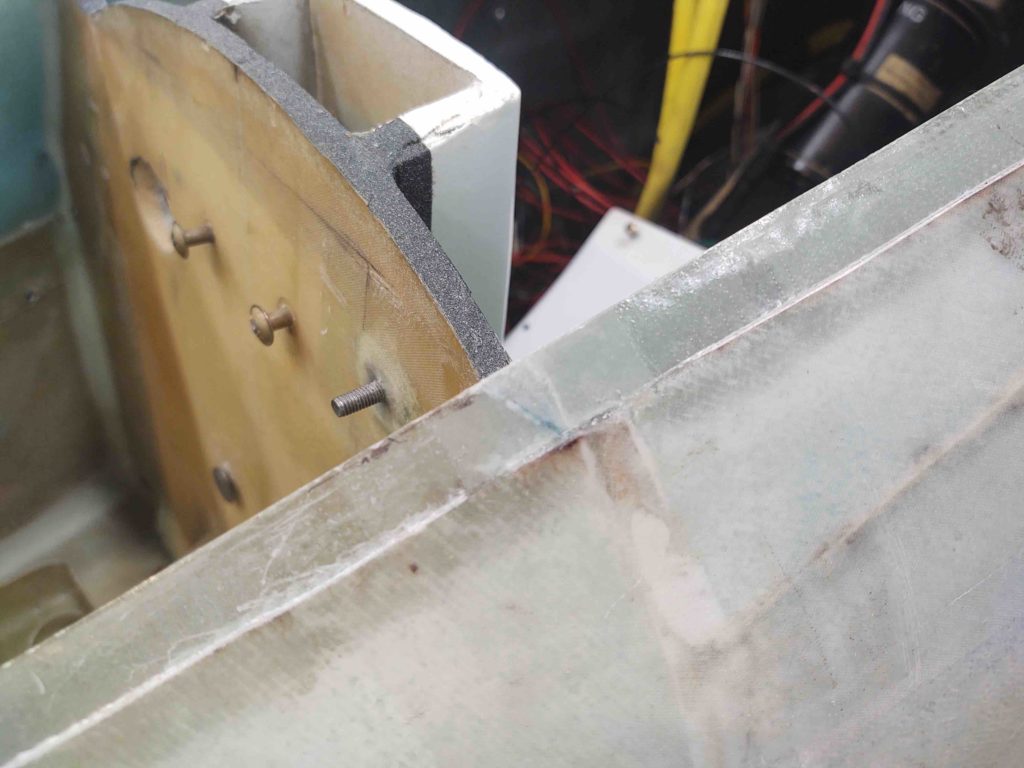
•••
20 October 2020 — My immediate goal is to get the nose hatch door latch installed, but before I can move forward with that I needed to finish glassing the underside of what I call the “nose bridge,” or the area in-between the nose hatch and the canard mounting opening, which is covered by the aft nose/avionics cover.
With different nose build ops having been done in this area involving microing in blue foam inserts, etc. there was a fair amount of cured micro blobs, mini-stalactites if you will, that were all along the seams of the blue foam under this area of the nose. In addition, the first couple of inches from the edge of the nose hatch going aft were shaped and glassed with a couple of plies of BID…. so a lot to get organized and glassed under this one little strip of nose.
I chipped, pried and cracked off the offending dead micro blobs, which then left me with some pretty nice divots along along the bottom surface of the “nose bridge.” Looked like the surface of a moon pummeled by asteroids… you get the picture. Clearly I needed to resurface this area before glassing, but gravity was kind of getting in the way for pour foam, and I wasn’t quite ready to invert my fuselage just for this one task.
So I decided to let the expanding pour foam do most of the heavy lifting, and I would merely provide a surface and some constricted space for it to work its magic. I took some thin cardboard, covered it with duct tape and then taped the front edge tightly to the existing glass. I also taped each side simply to keep the liquid pour foam from flowing out each end since the sides are lower than the middle section.
I then whipped up some pour foam, slathered it against the underside “nose bridge” foam surface as best I could and also on the surface of the taped cardboard. Once all the foam was out of my mixing cup I simply pushed the cardboard up a bit and taped it in place.
Voila! The pour foam expanded into and adhered itself into the crevices of the blue foam on the underside of the “nose bridge” and did exactly what I had hoped it would.
With the nose bridge ready for shaping and eventual glass, I then got busy on filling in the gap of the fuselage sidewall just forward and slightly below the canard leading edge. I taped off the canard on each side with clear packing tape, then used gray duct tape as a dam (aka form) both for the interior and exterior wall.
Here we have the right side ready to go just like the left side.
I then whipped up another batch of foam and poured it into the fuselage sidewall duct tape forms I had made.
And got the results I wanted here as well.
A little bit later I had trimmed and sanded down each fuselage sidewall to look like this.
And was still dialing in and shaping the foam for the “nose bridge.”
Getting much closer . . . at this point I removed the canard.
It may not look like it, especially with the glass laid up, but I did a lot of sanding both on the foam and the existing sidewalls in prep for new glass.
Here’s a shot from inside the nose hatch looking aft. You can see the existing glass across the front part of the “nose bridge” that makes up the lip of the nose hatch.
I used the rest of my thin cardboard to make up a template to cut the 2 plies of BID I was going to layup on the underside of the “nose bridge.”
Using a slightly too small piece of plastic, I then prepregged the 2 plies of BID.
I then laid up the BID on the underside of the nose bridge.
A shot of the new foam with 2 piles of BID laid up.
After peel plying the “nose bridge” layup, I then laid up a ply of BID on each of the freshly pour-foamed canard LE-fuselage corners. I then peel plied those layups as well.
•••
21 October 2020 — I started off today pulling the peel ply and cleaning up the layups both on the underside “nose bridge” and the fuselage corners just forward of the canard LE.
I then set the canard in place to test the fit and look of the new “fuselage corners.” I think these will work!
A shot of the whole shebang from a canard surface view.
•••
24 November 2020 — Today while I was waiting for the weather to warm up a bit to clear coat the interior cockpit paint, I decided to layup the bottom/LE canard contour in the nose just forward of F22.
I started off making my angled cuts along the edges for a nice flox corner, and then assembled and cut my BID glass (all scraps, of course). The small pieces of BID are for building up the thickness at the front of the contour to bring it closer to vertical, and closer to the canard LE.
I then laid up the BID and peel plied it.
A few hours later I pulled the peel ply off the nose contours for the canard bottom/LE. I then razor cut and cleaned up the edges of the glass.
I then re-installed the canard to check the fit…. I’m very pleased with how these layups came out. I’ll tape up the canard LE and then use micro to tighten up the gaps between the canard and the nose contours.
•••
